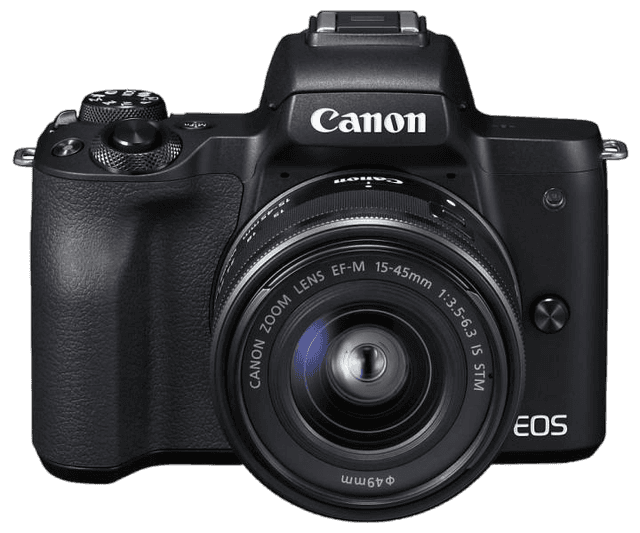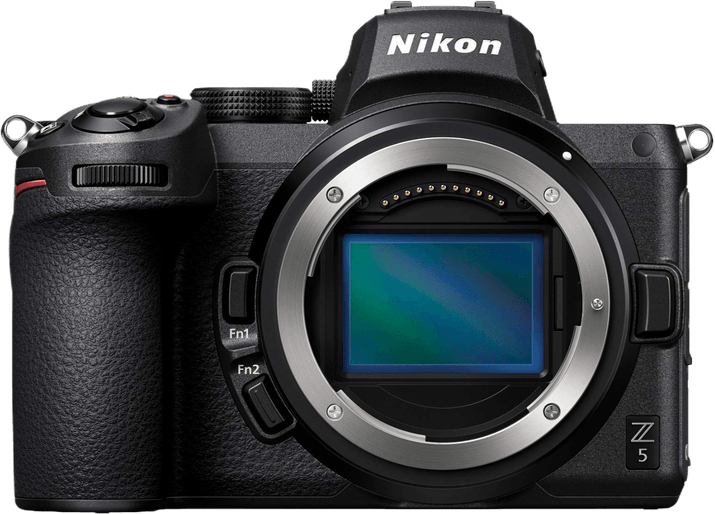Canon EOS M50 vs Nikon Z5 Comparison
Canon EOS M50

Nikon Z5

The Nikon Z5 outperforms the Canon EOS M50 with a 19-point lead, scoring 78/100 compared to the M50’s 59/100. Both cameras are mirrorless and were released in 2018 and 2020, respectively. They share similarities in their camera type and launch prices, with the M50 at $779 and the Z5 at $1400.
The Z5’s higher score makes it a better camera in terms of general specifications. It is larger, measuring 134 x 100.5 x 69.5mm compared to the M50’s 116 x 88 x 59mm, and heavier, weighing 675g / 1.49lbs against the M50’s 390g / 0.86lbs. These differences contribute to the Z5’s superior performance and capabilities.
However, the Canon EOS M50 has its advantages, such as being more compact and lightweight, which may appeal to those looking for a more portable option. Ultimately, the Nikon Z5’s higher score reflects its better performance, while the Canon EOS M50 offers a more convenient size and weight for those prioritizing portability.
Canon EOS M50 vs Nikon Z5 Overview and Optics
The Nikon Z5 wins in the optics comparison with a score of 81/100, while the Canon EOS M50 scores 59/100. Both cameras share some common specifications, such as having 24 megapixels, a CMOS sensor, and similar lens mounts (Canon EF-M for the EOS M50 and Nikon Z for the Z5).
The Nikon Z5 outperforms the Canon EOS M50 in several aspects. Firstly, it has a higher DXOMARK sensor score of 97 compared to the EOS M50’s 58, indicating a better image quality. The Z5 also features a full-frame sensor, which provides a larger surface area for capturing light, resulting in improved low-light performance and dynamic range. Additionally, the Nikon Z5 has image stabilisation, which aids in capturing sharper images in various shooting conditions.
On the other hand, the Canon EOS M50 has a faster shooting speed of 10 frames per second, compared to the Z5’s 4.5 frames per second. This advantage allows the EOS M50 to capture fast-moving subjects more effectively. However, this is the only area where the EOS M50 surpasses the Z5.
In terms of optics, the Nikon Z5 is the clear winner due to its higher sensor score, full-frame sensor, and image stabilisation. These features contribute to better overall image quality and versatility. The Canon EOS M50’s faster shooting speed is a notable advantage, but it does not outweigh the benefits offered by the Z5. Therefore, for those prioritizing optics performance, the Nikon Z5 is the better choice.
Canon EOS M50 vs Nikon Z5 Video Performance
The Canon EOS M50 outperforms the Nikon Z5 in video capabilities, with a score of 91/100 compared to the Nikon Z5’s 83/100. Both cameras offer 4K video resolution and have maximum video dimensions of 3840 x 2160. Additionally, they both come equipped with built-in time-lapse functionality.
The Canon EOS M50 surpasses the Nikon Z5 in terms of maximum video frame rate. The EOS M50 has a frame rate of 120fps, which is double the Z5’s 60fps. This higher frame rate enables the EOS M50 to capture smoother and more detailed slow-motion video, making it the better choice for those who prioritize this feature in their videography.
While the Nikon Z5 has a lower video score and frame rate, it still offers excellent video quality with its 4K resolution and built-in time-lapse functionality. For users who do not require the higher frame rate provided by the Canon EOS M50, the Nikon Z5 remains a solid option for capturing high-quality video.
Comparing the video capabilities of the Canon EOS M50 and the Nikon Z5, the EOS M50 emerges as the superior choice due to its higher video score and its impressive 120fps maximum frame rate. However, the Nikon Z5 should not be overlooked, as it still provides 4K resolution and time-lapse functionality, making it a viable option for those who do not prioritize slow-motion video capture. Ultimately, the choice between these two cameras comes down to the specific video needs and preferences of the user.
Canon EOS M50 vs Nikon Z5 Features and Benefits
The Nikon Z5 surpasses the Canon EOS M50 in features with a score of 72/100 compared to the M50’s 70/100. Both cameras share several specifications, including a touchscreen, flip screen, WiFi, and Bluetooth connectivity. Neither camera offers GPS functionality.
The Nikon Z5 outperforms the Canon EOS M50 in terms of its screen size, boasting a 3.2-inch display compared to the M50’s 3-inch screen. This larger screen size provides a more comfortable viewing experience and easier navigation of the camera’s settings. Despite the difference in screen size, both cameras have the same screen resolution of 1,040,000 dots, ensuring equal clarity and detail in image previews.
On the other hand, the Canon EOS M50 has two advantages over the Nikon Z5. Firstly, it has a lower price point, making it a more budget-friendly option for photographers. Secondly, the M50 is more compact and lightweight, making it easier to carry around and use for extended periods. However, these advantages do not necessarily translate into better overall performance.
In comparing the Canon EOS M50 and Nikon Z5, it is clear that the Z5 has the edge in terms of features, primarily due to its larger screen size. The M50, however, may be a more suitable choice for those prioritizing affordability and portability. Ultimately, the decision between these two cameras will depend on the individual photographer’s preferences and needs.
Canon EOS M50 vs Nikon Z5 Storage and Battery
The Nikon Z5 wins the storage and battery comparison with a score of 73/100, while the Canon EOS M50 scores only 13/100. Both cameras accept SD, SDHC, and SDXC memory cards, but the Nikon Z5 has two memory card slots and is UHS-II compatible, providing more storage options and faster performance. Additionally, the Nikon Z5 offers a significantly longer battery life of 470 shots, compared to the Canon EOS M50’s 235 shots. The Z5 also uses the EN-EL15c battery type and supports USB charging, making it more convenient for users on the go.
The Canon EOS M50, with a single memory card slot and UHS-I compatibility, still provides adequate storage for casual users. Its battery life, while shorter than the Nikon Z5, is sufficient for everyday use. The M50 uses the LP-E12 battery type but lacks USB charging.
Considering the storage and battery aspects, the Nikon Z5 clearly outperforms the Canon EOS M50, offering superior storage options, battery life, and charging convenience. While the Canon EOS M50 is suitable for casual use, the Nikon Z5 caters to more demanding photographers who require better storage and battery performance.
Canon EOS M50 vs Nikon Z5 – Our Verdict
Are you still undecided about which camera is right for you? Have a look at these popular comparisons that feature the Canon EOS M50 or the Nikon Z5:
